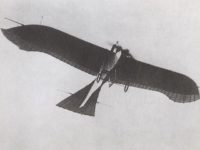The Etrich Taube was a lightweight single-engine two-seater sport, reconnaissance and training aircraft, developed by the Austrian Igo Etrich, which was used as the first standard aircraft by the German Air Force. The Taube was built by numerous manufacturers, including the German manufacturer Rumpler aircraft works, where the name Rumpler Taube comes from.
Development and construction:
The development of the Taube was based on the release of the flight characteristics of a palm-like tropical plant called Zanonia macrocarpa from Java. These research results were published in 1897 by the Hamburg Professor Friedrch Ahlborn, after which the Austrian pilot and aircraft designer Igo Etrich developed together with Franz Wels from the shape of the seed a wing.
Initially, this prototype was designed only as a glider, but after the flight characteristics were so balanced until 1909, could be installed by Porsche supplied 60PS engine. The first flight of the motorized Taube took place on 30.07.1909.
For the construction was almost exclusively used wood, tension fabric and bamboo sticks. Due to the hydrofoil shape based on the Zanonia vine, the aircraft was quite stable in the air, despite the absence of ailerons and wing flaps. Fast changes of direction were not possible.
In Germany, the aircraft was first built and sold under license by the entrepreneur Edmund Rumpler. As it became clear that Igo Etrich could not register a patent for the aircraft for Germany, Rumpler omitted the license payments and drove away the airplane under the name Rumpler pigeon on.
Due to the lack of patens, the aircraft type was not only built and sold under the name Rumpler Taube, but also under the name:
- Germania A.I
- Gotha A.I
- Jeannin A
Use in the First World War:
During the First World War, the Taube was only used as a reconnaissance plane, as it had neither armor or weapons, nor their speed would have been sufficient.
Only during the Battle of Tannenberg was a reconnaissance aircraft able to detect the movement of the Russian army and report this further, which led to the victory of the Germans in this battle.
Already six months after the outbreak of the war, the aircraft of the type Taube were withdrawn from the front and served only the training of pilots.
Technical specifications:
| Designation: |
Etrich (Rumpler) Taube |
| Country: |
German Empire |
| Typ: |
School and reconnaissance aircraft |
| Length: |
10 meters |
| Span: |
14,8 meters |
| Height: |
3,2 meters |
| Mass: |
650 kg empty |
| Crew: |
Max. 2 |
| Engine: |
4-cylinder Argus |
| Maximum speed: |
100 km/h |
| Reach: |
140 kilometers |
| Armament: |
none |
You can find the right literature here:
Fokker Dr I Aces of World War 1 (Aircraft of the Aces)
Undoubtedly the most famous fighter type to see service on either side during World War 1, the Fokker Dr I was a revelation when it entered service on the western front in 1917. Manfred von Richthofens JG 1 circus was the first Jasta to completely re-equip with the new fighter, and in the skilled hands of its numerous aces the Dr I proved a formidable opponent. The Dr I remained in service on the Western Front until replaced by the superior Fokker D VII in May 1918. Just weeks prior to that, however, Germanys leading ace, the great Red Baron, had been killed at the controls of a Dr I.
Friedrichshafen Aircraft of WWI: A Centennial Perspective on Great War Airplanes (Great War Aviation) (Volume 21)

Friedrichshafen Aircraft of WWI: A Centennial Perspective on Great War Airplanes (Great War Aviation) (Volume 21) Paperback – February 16, 2016
This book describes and illustrates the development of Friedrichshafen aircraft of WWI with text, 540 photos, 18 in color, 37 color profiles, production quantities and serial numbers of aircraft, and aircraft dimensions and performance specifications. In addition, there are 26 official SVK drawings and 11 aircraft are illustrated in scale drawings to 1/48 (4) or 1/72 (7) scales. The book has 312 pages and is of interest to aviation historians, enthusiasts, and modelers alike.
German and Austro-Hungarian Aircraft Manufacturers 1908-1918
Much has been written about the British aircraft of the First World War, but little has surfaced about the aircraft of the Axis powers, Germany and Austria. Here, Terry C. Treadwell tells the story of the aircraft from companies such as Fokker, builder of the famous triplane, as fl own by Baron von Richthofen's Flying Circus, AEG, Albatros, Junkers and Hansa. From reconnaissance aircraft to state-of-the-art bombers that could reach London, this is the definitive guide to aircraft of the Axis powers during the First World War. The aircraft are explained in detail and a history of each company is provided, making this an excellent source book for aircraft enthusiasts, model makers and those interested in the air war over the trenches of France and Belgium, as well as further afield in the Italian campaign.
The Zeppelin in Combat: A History of the German Naval Airship Division
The standard reference now revised and expanded. Dr. Robinson has opened up his vast photo archives to enhance this new edition of his classic work. Much of the new photographic material is published here for the first time.
This post is also available in:
 Deutsch (German)
Deutsch (German)  Français (French)
Français (French)  Italiano (Italian)
Italiano (Italian)  简体中文 (Chinese (Simplified))
简体中文 (Chinese (Simplified))  Русский (Russian)
Русский (Russian)  Español (Spanish)
Español (Spanish)  العربية (Arabic)
العربية (Arabic)
















